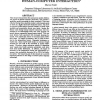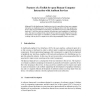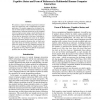6009 search results - page 53 / 1202 » Design-oriented human-computer interaction |
NAACL
1994
13 years 10 months ago
1994
This research characterizes the spontaneous spoken disfluencies typical of human-computer interaction, and presents a predictive model accounting for their occurrence. Data were c...
GI
2008
Springer
13 years 10 months ago
2008
Springer
: For the deployment of ambient services it is unrealistic to base user-computer interaction on traditional mouse or keyboard. Replacing them with other proprietary devices just mo...
BEHAVIOURIT
2007
13 years 9 months ago
2007
: Experimental research in human–computer interaction commonly uses participant groups that are unrepresentative of demographic realities, being young, technically knowledgeable ...
SSPR
2004
Springer
14 years 2 months ago
2004
Springer
Abstract. It is difficult to track, parse and model human-computer interactions during editing and revising of documents, but it is necessary if we are to develop automated technol...
AAAI
2000
13 years 10 months ago
2000
We analyze a corpus of referring expressions collected from user interactions with a multimodal travel guide application. The analysis suggests that, in dramatic contrast to norma...



